初中英语人教版八年级下册英语时态(共15张PPT)
人教版新目标初中八年级下册现在完成时态 ppt课件

现在完成时的含义及用法
1.现在完成时表示过去发生的动作,并 对现在有影响。
2.现在完成时表示从过去一直持续到 现在的动作或状态。
•5
现在完成时的基本句型:
肯定式: 主语 + 助动词have/has + 动词的过去分词.
否定式: 主语 + 助动词have/has + not + 动词的过去分
词. 疑问式:
up to now(到目前为止)
this morning/month/year(今天早上/这个月/今年)
•11
have been 与have gone 的用法比较
have been to “到过,去过”,表示曾经 到过某处,但现在人不在那儿。 have gone to “去了”,表示已经去了某 地,现在人可能在去的途中或已在那儿了。 have been in “呆在某处一段时间了”
for(长达) He’s lived in Shenzhen for 6 years.
in the past several days / weeks/ years(在过去的…)
recently(最近) I have not written to my parents recently.
so far(到目前为止) So far she has learned 5 English songs.
•12
Has she ever been to Nanjing? 她曾去过南京吗?
You have never been there, have you? 你以前从未去过那儿,是吗?
I have been to Guiling , I went there last year. 我去过桂林,我去年去的。
初中八年级英语下册一般将来时的表达课件

How can we express the Simple Future Tense
Ⅱ.一般将来时的五种表达方式:
3. be doing sth 表将来 现在进行时表示即将发生的动作,多与表示位移的动词come, go, arrive, leave fly, start等连用。 如: She is leaving for Beijing.(她就要启程去北京。leave for启程,动身)
1.当表示主观方面“打算, 准备” 去做什么事情的时候, 往往用be going to +动词原形, 而will 则多用来表示纯属客观的将来。
2.be going to+动词原形可表示事先计划的意图,而 will 则表示说话人当时决定的意图。
How can we express the Simple Future Tense Do some exercises
一般将来时的结构总结 Ⅲ.There be 句型的一般将来时:
2. There will be
肯定式: There will be+sth.
否定式: There will not be+sth.
一般疑问式: ——Will there be+sth?
(肯)——Yes, there will.
(否)——No, there will not.
–________ (好的). Yes, please B.Yes, you will.C.No, please.D.No, you won’t. 4.– Will his parents go to see the Terra Cotta Warriors tomorrow?
– No, ________ (不去). A.they willn’t.B.they won’t.C.they aren’t.D.they don’t.
英语人教版八年级下册初中英语语法动词时态复习课件1.
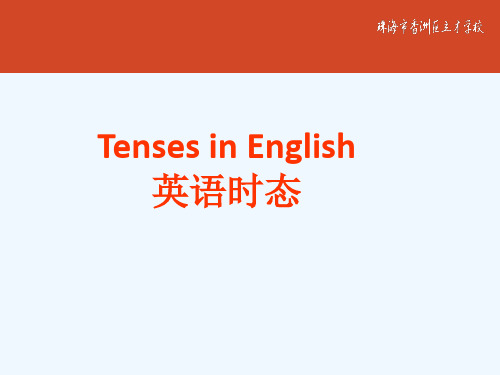
四、 一般过去时 1. 表示过去某一具体时间发生过的动作. e.g. I did my homework last night. 注意: 1)有时句中虽然没有表示确定过去时间 状语, 但根据上下文情景可以推断出是过去发生过的动 作,此时也应用一般过去时 e.g. I was sorry to learn of your illness. I didn’t know he was your father. 2)描述已故之人的动作或状态用一般过去时. e.g. Edison invented the electric light. 2. 表示过去经常反复发生的动作. He often swam when he was young. 3. 表示主语过去的状态或特征. e.g. It was rainy last week.
3. 有些表示状态或心理感觉的动词一般不用现在 进行时,而用一般现在时表示状态或感觉,如 love, like, hate, want, need, wish, know(知道), understand(懂得), remember(记得), believe, mean(意味着), think(认为), feel(认为), fit(合适), find(认为), show(表明), have(有) e.g. I know you are right. I want to visit them tomorrow. He likes English.
一般现在时与现在进行时的区别 1.进行时强调动作正在进行,而现在时强调动作的 经常和反复,或特征,这类动作没有时间性的. 2.某些表示感官知觉的动词如: see, hear, smell, taste等表示感觉,用一般时,不用进行时. e.g. Can you see a plane in the sky? 注意:1) feel 可以用一般时和进行时表示说话时 的感觉: e.g. How are you feeling today? I feel tired. 2) see, hear 有相应表示动作的动词 look at / listen to , 这些词可以用进行时 比较: Can you see a map on the wall? He is looking at a map on the wall.
人教版八年级下册Unit现在完成示范课件
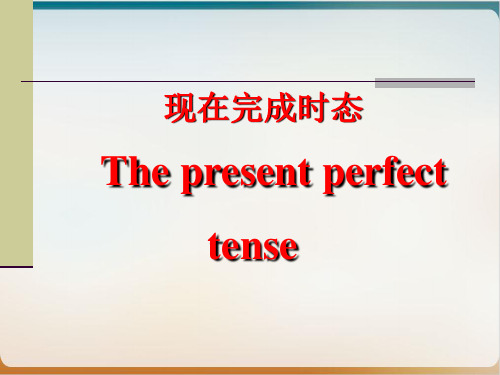
现在完成时动词构成 have /has+v 过去分词
助动词
否定
haven’t hasn’t
疑问
Have you…? Has he…?
翻译. ( English ===>Chinese)
1.翻译1)我已经写完作业了; 2)他已经写完作业了.
2.第一句变成否定句;
2.不规则动词 11.w.wilill/ls/shhaalll+l+vv原. 形 22.a.amm/i/sis/a/arereggooininggtoto++vv原. 形
am/is/are+v-ing
过去进行时 过去某一时 1.v-ed(规则动词) 间,在进行 2.不wa规s/w则e动re+词v-ing
I _h_a_v_e__ never _h_e_a_rd__ of anything like
that. (hear )
Key words
yet ever never since
Tom He _h_a_s_w__o_rk_e_d__ in the factory since he
left school ten years ago. (work )
up to now in the past 10 years
in his life lately recently
ever since then till now
He _h__a_s_t_a_u_g_h_t_ in this high
school till now. (teach )
易混点 have/has been to have/has gone to He has gone to Shanghai. 他(已经)去上海了。
初中英语动词的时态和被动语态(共14张PPT)
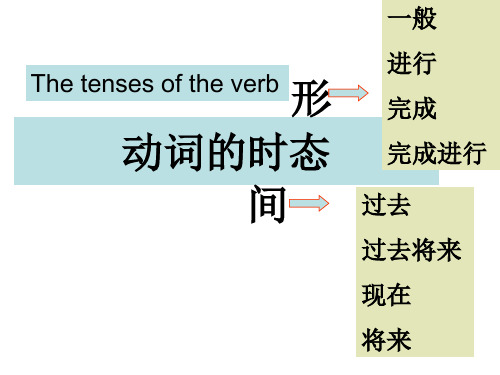
延续性动词 be on be at/in+地点 be at/in+地点 be in/a member of be on have know keep
have a cold
have been to—have gone to
曾经去过(主语人在) 已经去了(主语人不在)
--I can’t find you these days.Where have you been?
be over be up be back be away (from) be here /there
非延续性动词 put on come/go to arrive/reach/get to join begin/start buy get to know borrow / lend
catch a cold
定义 表示过去某时间或某动作以前发生的动作。
结构 关健字
S+had+V过去分词
IwSr+heheaanlidzIner’det+aIVchh过ae去dd分let词hftemcoyupHnutar.sde+Sa+t Vh过om去分e词
by the time I came back,by the end of last term, when I got to the station,before he went to bed
表示过去某时刻或某阶段正在发生的动作。
was
1.SW+hawtawsna’st /hwe edroein’gt dwohinegn the UFO arrived?
结构 S+ weredoing 2W. Tahse/yWweerree+hSav+idnoginfugn…th?ese days.
初中英语语法—时态(28张) PPT课件 图文

(4)现在完成时与表示一段时间的for短语、since短语或从句等 时,应注意句中的谓语动词须是延续性的,而不能是非延续性动词,如 come→be here,go→be there,die→be dead,borrow→keep,buy→h ,join→be in,leave→be away,begin to study→study等。
6.过去进行时
(1)概念:表示过去某一时刻或某一时间段内正在进行的动作。 (2)构成形式:was/were+动词的-ing形式 ①表示往返、位移的动词的过去进行时常可用来表示过去将来时
时态 We wanted to tell her that the train was_leaving an hour later.
1.一般现在时
基本用法: (1)表示经常性、习惯性的动作; He always helps others. 他总是帮助别人。
时态 (2)表示现在的情况或状态;
He is a teacher. 他是个老师。 (3)表示客观事实和普遍真理。 The sun rises in the east. 太阳从东边升起。 构成形式:am/is/are或实义动词的原形(主语是第三人称单数时,动 词要用第三人称单数形式)。
时态 (2)构成形式:have/has+动词的过去分词。
(3)与现在完成时连用的时间状语有for a long time,recently,yet, lately,ever,never,already,since,by this time,before,just,in t past/last few years,since+过去的时间点,since+时间段+ago,since +从句(一般过去时)。
表示感觉的动词。如:see,hear等。 表示喜欢或厌恶的动词。如:like,love等。 表示希望的动词。如:want,would like等。
人教版八年级下Unit9-10现在完成时态总复习(共17张PPT)

练一练。 1. I lost/have lost my wallet a week ago. 2. My sister finished/has finished her homework since an hour ago. 3. Miss Wu taught/has taught English last year. 4. We knew/have known each other for many years. 5. I'm sorry, I just h_a_v_e_b_r_o_ke_n(break) your favorite cup, could I buy a new one for you? 6. He __tu_r_n_e_d_____(turn) off the light just now. 7. Who _h_a_s_e_a_t_en____(eat) my dinner, I am still hungry! 8. The window _ha_s__b_ee_n__b_ro_k(ebnreak) for a week, could you help me to fix it up?
1.-----Would you like to see the film Confucius with me this evening? ------I’d love to, but I _______ it already.
A.had seen B.have seen C.watch D.am watching 2. -----Excuse me, where is Mr. Brown’s office ?
时间 决定 (谓语动词)形态 反映
二. 完成时态 have/has+done
八年级英语所学的全部时态以及语法
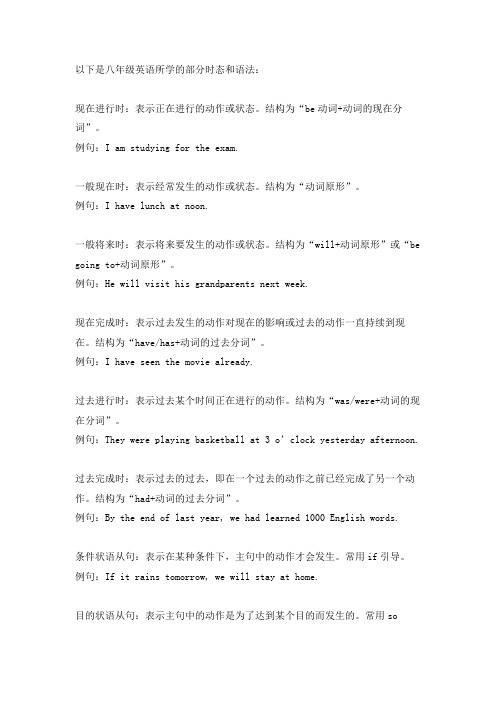
以下是八年级英语所学的部分时态和语法:现在进行时:表示正在进行的动作或状态。
结构为“be动词+动词的现在分词”。
例句:I am studying for the exam.一般现在时:表示经常发生的动作或状态。
结构为“动词原形”。
例句:I have lunch at noon.一般将来时:表示将来要发生的动作或状态。
结构为“will+动词原形”或“be going to+动词原形”。
例句:He will visit his grandparents next week.现在完成时:表示过去发生的动作对现在的影响或过去的动作一直持续到现在。
结构为“have/has+动词的过去分词”。
例句:I have seen the movie already.过去进行时:表示过去某个时间正在进行的动作。
结构为“was/were+动词的现在分词”。
例句:They were playing basketball at 3 o’clock yesterday afternoon.过去完成时:表示过去的过去,即在一个过去的动作之前已经完成了另一个动作。
结构为“had+动词的过去分词”。
例句:By the end of last year, we had learned 1000 English words.条件状语从句:表示在某种条件下,主句中的动作才会发生。
常用if引导。
例句:If it rains tomorrow, we will stay at home.目的状语从句:表示主句中的动作是为了达到某个目的而发生的。
常用sothat引导。
例句:He studied hard so that he could pass the exam.时间状语从句:表示在某个时间点发生的动作。
常用when, while等连词引导。
例句:When the teacher came in, the students stopped talking.比较状语从句:表示两个事物之间的比较关系。
初中英语人教版八年级下册五种英语时态

,
初中英语人教版八年级下册五种英语时态
目录
01
添加目录标题
02
一般现在时
03
一般过去时
04
一般将来时
05
现在进行时
06
过去进行时
01
添加章节标题
02
一般现在时
定义
用于描述事实、观点或习惯性行为
用于表示计划、安排或习惯性动作
一般现在时表示现在经常发生的动作或存在的状态
通常与时间状语连用如lwys、usully、sometimes等
常用时间状语:now, t the moment, right now等
示例句子:I m plying bsketbll now. (我正在打篮球。)
用法:表示正在进行的动作或状态
06
过去进行时
定义
添加标题
添加标题
添加标题
添加标题
过去进行时由"ws/were + -ing"构成
过去进行时表示在过去某一时刻正在进行的动作或状态
现在进行时与一般现在时的区别和用法
用法
表示正在进行的动作或存在的状态
表示动作的持续进行
表示即将发生的动作
表示暂时性的行为或想法
结构
定义:表示正在进行的动作或状态
结构:be动词+动词ing
时间状语:now, t the moment, these dys等
用法:描述当前发生的动作或状态
示例
句子结构:主语+be动词+动词ing
通常与时间状语连用如yesterdy、lst night、in 1990等
结构为“主语+动词过去式+其他”
初中英语语法时态(共25张PPT)

A.goes B.will go
C.would go D.are going
2.--Did your son fail his English exam once again?
--Yes, but he told me he____hard next term.
A.studies B.is studying C.will studyD.would study
2 have been to+地点,表示“去过某
地”。(人已回) I have been to Europe. (I am not in Europe now.)
3 have been in+地点+时间段,表示“在/ 来某地多久”。
I have been in Europe for three weeks. (I am now still in Europe .)
3.现在完成时和一般过去时的异同点: 1 共同点:动作都在过去。 2 不同点:和现在有无关系。(与现
在有关的过去动作用现在完成,与现在 无关的过去动作用一般过去。)
4.易错点:
1 have gone to+地点,表示“去了某地”。
(人已走,尚未回。只用于第三人称。)
They have gone to Europe. (They are not here.)
C.didn’t he
D.did he
三、现在进行时
1.用法:
A.现刻动作:目前正在发生的动作。
B.现阶段动作:目前一个时期一直在进 行的动作,此刻不一定在进行。
2.标志词:now,Look! Listen!
中考模拟:
--Mike, who____football in the yard?
初中英语人教版八年级下册语法课件
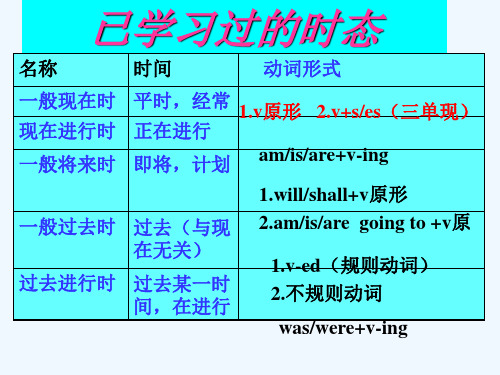
判断下列句子的时态
• 1.She works in a factory. 一般现在时 • 2.I was doing my homework at this time yesterday. 过去进行时 • 3.We are going to have a picnic this Sunday.
一般将来时
ever : 多用于疑问句. 例Has your father ever spoken to a foreigner? never :用于否定句,位于have/has后 例:We've never met such a tall man.
just : 多用于陈述句,位于have/has后 例:Lucy has just washed her clothes. before :可用于各句式,位于句尾。 例:I have read this book before. He hasn't been abroad before. Have you flown to Hainan before?
• 4.They held a sports meeting last week.
一般过去时
• 5.Are you helping your mother ?
现在进行时
Present Perfect Tense
现在完成时态的用法
表示已完成的某一动作对现在造成的 影响或结果
一、结构: 二、句式: 三、用法及标志词: 四、注意事项:
标志词:
三、现在完成时态的用法:
already :多用于陈述句,位于have/has后,有时 位于句尾。 例:I have already finished my homework. yet : 用于疑问句和否定句,位于句尾。 例:Have you found your lost book yet ? I haven't had breakfast yet.
英语人教版八年级下册初中英语时态教学课件

中考考点·精讲
动 词
一般现过将在去来时时时:::谓谓谓语语语动用用词动wi用词ll/s原的ha形过ll/或去be第式go三ing人t称o+单动数词原形
的
时 态
现在进完行成时时::谓谓语语用用ahmav/eis//haarse++动动词词的的过现去在分分词词
句中可以和一段时间连用。
The rich woman is always laughing at the poor. 这个有钱的 女人总是嘲笑穷人。
谢谢观看!
种类
现在 完成 时
谓形式
用法
1.表示过去发生的动作对现在造成的影响 和结果。 2.表示动作从过去开始一直持续到现 have/has+ 在,并有可能继续下去,常与“for+时 动词的过 间段”或“since+表示过去的时间点或 去分词 时间段”连用。 注意:终止性动词在现在完成时中不能 和表示一段时间的状语连用,但在否定
过去进行时:谓语用were/was+动词的现在分词
动词的语态被 主动 动语 语态 态
动词的时态
种类
be动词的一 般现在时
行为动词及 其他连系动 词的一般现
在时
谓语形式
is, am, are+ 表语,根据 人称而定
1.动词原形 2.主语是 单数第三人 称,谓语
加s,es
用法
表示现在的状态
1.表示过去发生的动作。 2.表示过去经常发生的动作。 3.用于虚拟语气中,表示与现在 事实相反的情况。
1.表示说话时或目前正在进行的动 作。 2.与always,usually等词连用, 表示赞扬、厌恶或不满的情绪。
种类 过去进行
时
一般将来 时
谓语形式 was/were+动 词的现在分词
- 1、下载文档前请自行甄别文档内容的完整性,平台不提供额外的编辑、内容补充、找答案等附加服务。
- 2、"仅部分预览"的文档,不可在线预览部分如存在完整性等问题,可反馈申请退款(可完整预览的文档不适用该条件!)。
- 3、如文档侵犯您的权益,请联系客服反馈,我们会尽快为您处理(人工客服工作时间:9:00-18:30)。
in the morning? • 5.My mother__l_ik_e_s___(like) g_o_i_n_g__(go)
shopping.
一般现在时the simple present
Exercise
• 1. I _w_a_tc_h_e_d (watch) a cartoon 2 days ago.
• 2. Her father __r_e_a_d__ (read) a newspaper last night. • 3. We __w__e_n_t___ to the zoo yesterday. (go) • 4. _D_i_d___ you _v__is_i_t__ (visit) your relatives last Spring
一般过去时the simple past
1.表过去发生的事情或存在的状态 eg Suddenly,the clouds cleared and the rain stopped.
2.表过去经常发生的事情 eg I was very thin in my childhood .
3.带有确定的过去的时间状语 eg Did you meet yesterday? He left just now.
eggs.
• When he knocked at the door, my auntw__as coo_k_i(ncgook)
• The students w__as si_n_g_i_n(gsing) andw_as dan_c__in(gdance)
happily on the playground at that time.
用 进行的动作
过去的一个动作发生的时候,
法
b.在口语中(go, leave, die, 另一个动作发生正在进行 arrive等)用进行时态结构
表示将要发生的动作。
基 本
结 am/is/are + doing
构
标 志 now, at this time, at 词 the moment, these
a. If引导宾语从
句,“是否”,…
b. If引导状语从
句,“如果”…
时态中的“特殊”对策的 原则:
5. The teacher told us
December 255 ChrissttmmaassDay.D(a辽y宁)
A. is B. was
C. has been
宾语从句表示客 观真理,时态不 受主句限制而用
days, look, listen等
was/were + doing
at that time, at this time yesterday, when, while…
Exercise
• The doctors __a_r_e__g_e_t_t_in__g_________ (get ) off the bus. • Come on. They __a_r_e_l_e_a_v_i_n_g______ ( leave ) now. • The white cat is __e_a__ti_n_g______ (eat) fish. • My father __i_s_n_'_t_w__o_r_k_i_n_g____(not work) in the office
2.表说话人的意图、打算或某种可能性 eg Who is going to speak first? 3.按计划要发生的动作或命令他人做某事 eg The new bridge is to open to traffic in 3 days.
时
态
现在进行时
过去进行时
a.表示现阶段或说话时正在 过去某时正在进行的动作或状态;
一般现在时
• • 1.根据时间状语确定时态 • 2.在复合句中根据时态呼应确定时态,即时
态一致原则
• 3.主将从现原则 • 4.根据上下文已有的时态信息判定时态,体
现在选词填空上。
根据时间状语确定时态的原则:
1. EEvveerryy ssuummmmeerr many foreigners _____ to Hainan for vacations. A. comes B. came C. come D. coming
Festival?
• 5. He often __fl_e_w___ (fly) a kite when he was a child.
一般将来时 the simple future
主语+ will\shall+v原形.
1.要在将来的某个时间内发生,是“纯粹的将来动作”。 eg I shall / will not be free tomorrow.
A. watches B. watched C. is watching
D. watching
在复合句中根据时态呼应确定时态的原则:
4. Do you know if he back next week? If he
____, please let me know.
A. comes; will come B. will come; will come C. will come; comes D. comes, comes
now.
• ---Where is your mother?
---She _is__a_n_s__w_e_r_i_n_g___ (answer) the phone.
Exercise
• Later his parents found that he w__a_s_ sitti_n(gsit) on some
一般现在时除主语是:A:be动词(am,is,are)B:实义动词 原形(第三人称单数时谓语动词要加s)。
1.表经常发生的事情、存在的动作或状态 eg .She sings with the band Crazy Boy.
2.表内心活动感情等 eg .I don't think you are right.
3.描述客观真理 eg .Light travels faster than sound.
4.表预定的行为 eg .The train leaves at 9.
同学们,考点 在这里!
5.当主句的谓语动词是一般将来时, 时间或条件状语从句的谓语动
词只能用一般现在时来表示将来要发生的动作
e.g.I'll tell him the news when he comes back tomorrow.
根据上下文已有时态信息点确定时态的原则:
2. –Is your mother a nurse? --Yes, she is. She ____ in Town Hospital.
A. has worked B. works C. worked D.working
利用上下文语意确定时态的原则:
3. –Whe’re’ss your mother, Lucy? --She _____ TV in the room.
Welcome to the class!
Байду номын сангаас
Tense 时态
8 types
一般现在时 一般过去时 一般将来时
现在进行时 过去进行时
过去将来时 现在完成时 过去完成时
Exercise
• 1.I like __s_w_i_m_m__in__g__ (swim). • 2.He ___r_e_a_d_s__(read) English every day. • 3.We ___g_o_____(go)to school at seven in the
• I _w_a_s wr_iti(nwgrite) a letter while my brother was listening to
music.
were planting
• We had no classed at this time yesterday. We ___ _ (plant) trees.
